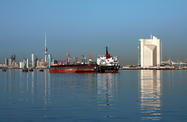Ports in Kuwait have performed well in recent years, supported by a national bid to increase both hydrocarbon exports and non-oil commercial shipping activity. However, while plans to upgrade facilities and improve access to new oilfields bode well for the industry, the sector also faces several challenges, led by fluctuations in global demand and regional competition.
Steady growth
Kuwait’s economic infrastructure relies heavily on the country’s three main commercial ports of Shuaiba, Shuwaikh and Doha. The larger ports of Shuaiba and Shuwaikh together handled 98% of exports in 2012, according to the Kuwait Central Statistics Bureau (KSCB), while Doha was responsible for coastal vessels and barges travelling between ports. Hydrocarbon exports and bulk commodities are shipped through Shuaiba, located just south of Kuwait City. The facility borders Ahmadi and Mina Abdullah Ports, which serve nearby oil refineries to the north and south.
The sea shipping sector has grown steadily in recent years. Figures published by the KSCB showed that the number of oil tankers cleared from Kuwait’s ports rose from 1424 in 2010 to 1469 in 2012. Total cargo volumes jumped from 27.32m tonnes to 35.94m in the same period, up 31.55%, although over a longer period, growth was more modest. Between 2005 and 2012, cargo volumes measured by tonnes increased at a compound annual growth rate of 1.59%, according to a January report from investment company Kuwait Financial Centre Markaz.
The Markaz report was relatively bullish on the sector, pointing out Kuwait’s advantageous geographic location, growing trade and expected increase in oil exports. The planned trans-GCC rail project, a multi-billion-dollar, 2200-km line that will cross Kuwait when completed, is set to increase demand across the state’s ports.
The investment company also noted an anticipated “lack of handling capacity in the GCC region between 2013 and 2014”, which is expected to contribute to sea transport growth in Kuwait this year.
Retaining competitiveness
However, in the longer term, Kuwait faces increasing competition from regional peers, which have been quicker to increase capacity by investing in infrastructure. Domestic political uncertainty and delays in enacting the National Development Plan have hampered growth across the state, and better Customs handling procedures could improve efficiency at the country’s ports.
Kuwait achieved mixed results in the Agility Logistics Emerging Markets Index 2014 survey, slipping two places from 16th to 18th out of 45 countries surveyed, and ranking fifth in the GCC. The country also dropped from 5th to 6th position for market compatibility, which rated accessibility, business regulations, foreign direct investment, risks and threats, and demand for logistics services. However, it edged up from 28th to 27th for market connectedness, which assessed the quality of transportation infrastructure.
Private sector participation
Several of Kuwait’s planned industry upgrades and new construction projects are already taking shape, including the $1.2bn Mubarak al Kabir (MAK) Port initiative on Boubyan Island, which was launched in 2011 and should substantially increase domestic handling capacity. Four key stages of the project, including dredging to allow access for super tankers and the construction of 24 new berths, are set to be completed this year. According to the Markaz report, the government plans to privatise MAK and other ports, and took steps in September 2013 to begin this process.
Kuwait’s drive to upgrade its ports has provided opportunities to multi-national construction companies and other sector players. Technical and management support company AECOM won a contract to design a 40-km water navigation channel at MAK in 2013, while the CCCC Guangzhou Dredging Company clinched a $15m deal in the same year to develop a dredging channel as part of the Sabiya causeway. Meanwhile, Turkish contractor STFA is set to work on a planned $487m expansion to the port used to transport oil from the Mina Ahmadi refinery, which will help the state meet its goal of exporting 4m barrels of oil per day
The raft of new construction projects will support Kuwait’s ports as they prepare to expand their operations in a challenging market. While infrastructure delays may have given regional peers an edge, Kuwait’s strategic location, together with its plans to boost oil exports, should provide an opportunity for the country to make up ground.
Follow Oxford Business Group on Facebook, Google+ and Twitter for all the latest Economic News Updates. Or register to receive updates via email.

